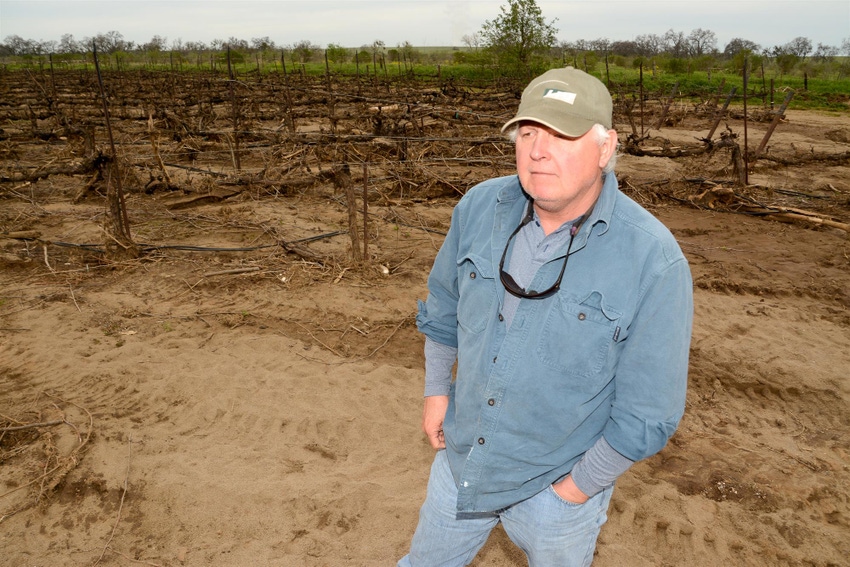March 17, 2017

In 17 years of farming wine grapes in the foothills east of Lodi, Calif., Bill Berryhill has never seen anything like this; not here.
Heavy rain in mid-January pushed the ironically-named Dry Creek over its banks, through levees, and across hundreds of acres of grapes and walnuts Berryhill farms near the tiny San Joaquin County community of Clements.
He’s not alone. Other farmers in the region reported similar circumstances that in some cases left standing water in vineyards and orchards well into March. He mentioned one grape grower friend on the Mokelumne River who has more than 400 acres of vines under water two months after the floods first came.
“I would say that 85-90 percent of this ranch was under water three different times,” Berryhill said while offering Western Farm Press a driving tour of his grape and walnut operation.
The costliest of damage for Berryhill is likely in his Chardonnay grapes. Out of 100 acres of Chardonnay grapes inundated by flood waters, Berryhill will likely have to replace about seven acres of vines, plus poles, wire and irrigation lines.
First, he needs to get in and more completely assess the damage; a process he admits is overwhelming. In his 100-acre block of Chardonnay, about 15 acres could have millions of cubic yards of sand and gravel to be removed.
The challenge in removing it is getting between the rows with machinery to efficiently remove the debris without damaging vines. Time will not be his friend as some of those vines are buried in debris above the graft union.
“I’ve got to get the dirt away from the graft,” he says. “You don’t want dirt above the graft because then the Chardonnay will root itself and you’ll lose the benefits of the rootstock.”
Berryhill already has several large piles of debris stacked near his Chardonnay vineyard. He has no idea how many more large piles he will accrue as he clears the damage from his vineyards and orchards.
Irrigation lines, stakes, and poles need repaired and replacement across the ranch. In his walnut orchards, irrigation lines that once neatly sat on the surface along the tree rows are now strewn across the landscape. If that’s not enough, he plans to remove 25 acres of walnuts for reasons other than the flood.
All this work doesn’t account for the needed repairs on at least two levees. Berryhill suspects he won’t get started on levee repairs until summer when the creek dries up and he’s had a chance to remove millions of yards of sand and gravel from the vineyards and orchards.
“Then the question becomes: Will I replant this?” Berryhill says. “I’ll probably replant it and cross my fingers that this doesn’t happen again.”
Further challenging the repairs, Berryhill says the flood waters apparently relocated rattlesnakes from upstream locations. Prior to this event, Berryhill has seen one rattlesnake in 17 years on the ranch. As of early March, he’s seen more. Given the amount of debris piled around vines and trees, he can only surmise how many rattlesnakes are out there.
Aside from the Chardonnay grapes, Berryhill also grows Merlot, Cabernet Sauvignon, Sauvignon Blanc and Zinfandel at this location.
Harvest rains
California’s epic winter rains began about the time Berryhill was winding up harvest activities last November. Just as harvest ended his Clements ranch received about three inches of rain.
By the time January rains came the soil was saturated. Then another seven inches of rain fell over the course of a few days, pushing Dry Creek beyond its banks and through levees designed to protect the ranch.
In addition to his grapes, more than 100 acres of walnuts were devastated, leaving debris wrapped around the bottom of the trees and sand completely covering irrigation sprinklers that weren’t already washed away with the surface drip lines lying atop the walnut berms.
Berryhill’s ranch straddles the San Joaquin and Sacramento County line east of Stockton. Because of a disaster declaration that includes San Joaquin and Sacramento counties, Berryhill qualifies for natural disaster assistance from the federal government, according to the Farm Service Agency (FSA).
Berryhill has not yet sought disaster assistance since program information has been slow getting to affected growers.
Federal disaster assistance
In total, 24 California counties have received disaster designations, making farmers in those locations eligible for certain disaster-assistance programs. These counties include: Calaveras, Fresno, Inyo, Kern, Kings, Los Angeles, Madera, Mariposa, Merced, Mono, Monterey, Orange, Riverside, San Benito, San Bernardino, San Diego, San Joaquin, San Luis Obispo, Santa Barbara, Santa Clara, Stanislaus, Tulare, Tuolumne, and Ventura.
Farmers and ranchers in the contiguous California counties of Alameda, Alpine, Amador, Contra Costa, Imperial, Sacramento, San Mateo and Santa Cruz also qualify for natural disaster assistance.
The disaster declaration was announced Feb. 23, making all qualified farm operators in the designated areas eligible for FSA’s emergency (EM) loans if eligibility requirements are met.
Farmers in eligible counties have eight months from the declaration date to apply for loans to help cover part of their actual losses. FSA will consider each loan application on its own merits, taking into account the extent of losses, security available and repayment ability. FSA has a variety of programs, in addition to the EM loan program, to help eligible farmers recover from adversity.
Other FSA programs that can provide assistance, but do not require a disaster declaration, include Operating and Farm Ownership Loans; the Emergency Conservation Program; Livestock Forage Disaster Program; Livestock Indemnity Program; Emergency Assistance for Livestock, Honeybees, and Farm-Raised Fish Program; and the Tree Assistance Program.
Interested farmers can contact their local USDA Service Center for further information on eligibility requirements and application procedures for these and other programs.
Additional information is also available online at http://disaster.fsa.usda.gov.
You May Also Like




